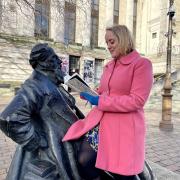'You can’t put a value on grabbing someone before they go under'
So says senior helm Andrew Ferguson, who’s 20 year service at Hayling Island station has inspired a future generation
‘O hear us when we cry to Thee, For those in peril on the sea’. These words are from Eternal Father, Strong to Save (1860), a hymn traditionally associated with seafarers, especially those in the maritime armed services, but one that also has resonance for those operating in the civilian marine world – including the brave personnel of the Royal National Lifeboat Institution (RNLI).
Lifeboats existed before the RNLI, with the first purpose-built craft stationed at South Shields in 1790. It was almost another 35 years before the National Institution for the Preservation of Life from Shipwreck was established by Sir William Hillary, in March 1824. It didn’t take long for the heroism of its crews to be recognised; the first Gold Medal awarded to Charles Fremantle who saved a wrecked brig off the Hampshire coast, also in 1824. In 1854 the charity’s name was changed to the Royal National Lifeboat Institution and this year it celebrates its 200th anniversary.

The UK’s coastal communities, including Hampshire’s, know and respect the sea. In peacetime it provides pleasure and sustenance. During wartime it is our ‘moat defensive’, protecting us from foreign foe. During World War I, lifeboats were launched 1,808 times and saved 5,332 lives. This heroism was repeated in World War II, when another 6,376 lives were saved, with 19 lifeboats helping with the Dunkirk evacuation alone.
The scale of today’s operation is staggering. RNLI volunteer lifeboat crews and lifeguards saved 506 lives in 2022 alone and helped 39,680 souls. Tragically, around 140 people die annually in UK and Irish coastal waters and the RNLI’s vision is to save every single one of these. The RNLI works with communities and partners to try to prevent people getting into danger in the first place, with males over 15-years-old most at risk. It is not just about the crew members braving the waters (of whom only one in 10 has a maritime profession), there are thousands of dedicated fundraisers too, plus volunteer shore crews helping with the launching and recovering of lifeboats. The 238 UK and Irish lifeboat stations cover 19,000 miles of coastline, with 441 lifeboats (including relief-fleet vessels) and seven hovercraft, whilst RNLI lifeguards patrol 240 UK and Channel Island beaches.

Hampshire is among the dozen or so UK areas that account for over half of accidental coastal deaths and Senior Helm at Hayling Lifeboat Station, Andrew Ferguson has seen plenty of rescues, and sadly tragedies, in his 20 years’ service. Hailing from Scotland originally, Andrew moved to London in 1992 for a career in aviation engineering before settling on Hayling Island in 2003, he remembers: ‘I had a house 200 yards from the lifeboat station, so what happened next was probably inevitable. The chap next door was shore crew and told me people like me were needed, within a few days I was introduced at the station.’
Despite no previous experience, Andrew never felt out of his depth, explaining: ‘Although I’d used the water before, I didn’t know much about the charity, but never had any doubts about joining. I spent nine months ashore before going afloat and I’ve now given 20 years’ service.’

Hayling Island’s precarious location, with its mix of commercial and leisure crafts and watersports mean the station is always busy, and it responded to over 100 callouts in 2023, an increase on 2022’s 82. ‘We have lots of traffic’ explains Andrew, ‘With a big mix of commercial, leisure, swimming, sailing, surfing; everything to do with the water. It really is constant all year at Hayling, although there are still busier times. After the holidaymakers go, we tend to get different incidents. There’s lots of medical emergencies too.’
Andrew has managed to balance his commitment to the RNLI by working from home and using the stations in Portsmouth and Hayling Island as a base when he needs to, something which his whole family has supported. Now, his two sons, Ross and James, are following in his footsteps as trainee boat crew. Andrew shares: ‘My boys were brought up with it. James wasn’t even born when I started whilst Ross was only three years old. They wanted to be at the station all the time; they’d have their wellies on at the door when I was heading out on a shout. When they were a bit older, they’d sit on the beach just watching, gripped by the whole thing. Their whole life revolved around it, and they just accepted it. Both boys are now competent sailors and powerboaters. I didn’t ask or push them to join. One day James just said he wanted to and then Ross did the same. It was their choice; they do it because they want to, and they do it really well. Although I’m very proud of them, I’m saying that as a senior helmsman, not their dad. I’m so close to my boys and we have a fantastic relationship’.

When it comes to working together, Andrew continues: ‘At the station I’m not their dad but a senior helmsman, and they’re respectful of that. In fact, they probably get a harder time than the rest so no-one can ever accuse me of favouring them. The others knew their abilities before they joined. They were pretty much born on the water so are competent under their own steam. James is a powerboat instructor but won’t challenge any decision I make; we may debate it afterwards but not at the time. My boys were lucky enough to join with several of their friends, other like-minded individuals, and they’ve all been dubbed the ‘boy band’. I feel the future of Hayling station is secure with this age group being so committed. I smile quietly when I see my sons in the boat in their kit, but I’m beaming inside.
In September 2022, Andrew received a Medical Director Commendation for his actions in saving a life when not on duty. He brought a lady back to life after over 20 minutes of CPR (in a pub called The Lifeboat). The emergency crew confirmed she would not be here today without Andrew’s prompt life-saving actions. But as he says, ‘I’ve devoted the best part of half my life to the RNLI, but I certainly don’t do it for any self-gratitude. If just one person is helped it’s worth it. Being a volunteer has given me a lot more in life than I could ever give to the RNLI and Hayling station; I’ve learned so much from doing it. I’ve met people and built relationships that I wouldn’t have had. We lose sight of a true perspective sometimes with the world so focused on money nowadays, but this is just humanitarian. You can’t put a value on grabbing someone before they go under.’

The cost of running the RNLI in 2022 was £188m. Of every £1 raised, 81p funds lifesaving activities, with the remainder used to generate more funds. Says the charity, ‘The RNLI is independent of the government – less than one per cent of our funding comes from government sources. Our lifesaving service depends on the kindness of our supporters – 94 per cent of our total income comes from donations. The remaining six per cent comes from income sources such as trading and investments.’
To support this vital and worthy institution for those in peril on the sea, see rnli.org – look out for activities celebrating its 200th year.



























